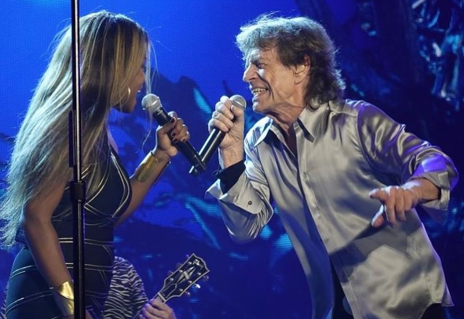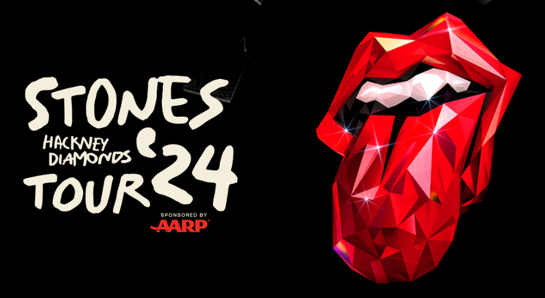[Note: New Music Musings, my weekly look at newly released music, will resume next Saturday]
Who would have thought we’d ever see a Rolling Stones tour sponsored by AARP? I don’t mean this in a disrespectful way – after all, I’m a member of the club, and it’s safe to assume so are most other Stones fans in the U.S. For non-American readers who may not be familiar with it, AARP (formerly known as American Association of Retired Persons) is a non-profit, non-partisan interest group focused on issues affecting people age 50 and above. Mick Jagger (80), Keith Richards (80) and Ronnie Wood (76) certainly have reached a stage in their lives by which I hope I’ll be long retired, but that doesn’t mean they’ve forgotten how to rock. The Stones’ remarkable ongoing ability to deliver a great rock & roll show was on full display on Thursday evening (May 23) at MetLife Stadium in East Rutherford, NJ.
Like the recent Neil Young & Crazy Horse gig I attended, my decision to see the “greatest rock & roll band in the world” was driven by nostalgia and, yes, the thought this could be the last time – no pun intended! Yet another similarity was an uncertain weather forecast that until the night before included a high chance of late afternoon/evening scattered thunderstorms with possible hail and strong wind gusts. In the end, time was on my side and other attending folks, and the weather gods were kind. I guess unstable weather conditions during what used to be fairly safe seasons of the year have caught up with open air shows – something that going forward I’ll have to factor in when deciding whether or not to purchase concert tickets for certain venues!
It’s hard to believe Thursday evening’s show happened nearly five years after my previous Stones concert in August 2019 at the same venue. I had seen them first in October 2005 at Hersheypark Stadium in Hershey, Pa. In addition to Jagger (lead vocals, guitar, harmonica, percussion), Richards (guitars, backing and lead vocals) and Wood (guitars), the Stones’ line-up included Chuck Leavell (keyboards, backing vocals), Matt Clifford (keyboards, percussion, French horn), Tim Ries (saxophone, keyboards), Karl Denson (saxophone), Darryl Jones (bass) and Steve Jordan (drums), as well as Chanel Haynes (backing vocals). I don’t quite understand why Leavell and Jones haven’t become official members, given their long tenures of 41 and 31 years, respectively!

While the Stones have called it the Hackney Diamonds Tour in a nod to their most recent studio album from October 2023 I reviewed here, it was really more of a greatest hits set, mixed with three songs from Hackney Diamonds and a couple of deeper cuts. But this didn’t make me angry – in fact, I loved the variety, and it was evident the audience shared my sentiments! The setlist mostly drew from Stones albums released between the mid-’60s and the late ’70s, such as Aftermath, Beggars Banquet, Sticky Fingers, Exile on Main St. and Some Girls. The only exception apart from Hackney Diamonds was Tattoo You (1981). There were also a couple of non-album singles.
Before getting to some Stones music, I’d like to acknowledge talented opening act Jon Batiste, a New Orleans pianist and vocalist who blends jazz, soul, pop, gospel, and R&B. He has recorded and performed with the likes of Stevie Wonder, Willie Nelson, Ed Sheeran and Lana Del Rey, and together with his band Stay Human could be seen each night as bandleader and musical director on CBS’s The Late Show with Stephen Colbert from 2015 to 2022. Some of Batiste’s best-known songs and renditions include Freedom (2021), It’s Alright (2022) and I Need You (2021).
After Batiste’s outgoing and groovy 45-minute opening set and a short break it was time for The Rolling Stones. Appropriately, they charged out of the gate with Start Me Up. Credited to Jagger-Richards as usual, the lead single from their August 1981 album Tattoo You has become a staple of their live shows. Seeing one of my all-time favorite bands again made a grown man cry – okay, not literally, but I can’t deny it was an emotional moment!
It’s Only Rock & Roll (But I Like It) perhaps best embodies why I’ve loved the Stones for 40-plus years. The classic title track of their October 1974 studio album once again is credited to Jagger-Richards, though then-new guitarist Ronnie Wood contributed to it. Notably, the song’s basic rhythm track came out of a jam session with Wood and his Faces bandmate drummer Kenney Jones, along with Jagger, David Bowie and bassist Willie Weeks. Richards subsequently added some guitar overdubs.
And then it was time for the man with the pirate laughter to sing a couple of songs on lead vocals, as has been custom at Rolling Stones shows. Vocally, Keith Richards ain’t no Mick Jagger, but I’ve always dug his somewhat unpolished voice. Here’s I Got the Silver, the first of two songs Thursday evening, which Richards performed on lead vocals. The country blues is off the November 1969 Let It Bleed album – the first song at the time featuring Richards on lead vocals throughout. Also, check Woods on acoustic slide guitar!
There were so many great songs the Stones played Thursday evening, which made it hard to pick what to capture. Before getting to Gimme Shelter, I’d like to acknowledge their great rendition of Miss You, a song that generally isn’t among my favorites. Among others, the extended version featured neat solo action by Jagger, Daryl Jones and Karl Denson on harmonica, bass and saxophone, respectively. Gimme Shelter, another track from Let It Bleed, was one of the songs during which Chanel Haynes got to showcase her incredible vocal pipes – driving the audience gaga without the artist of the same name!
After about 1.5 hours, the Stones closed their official set with another goodie and long-time favorite: Jumpin’ Jack Flash, a non-album single the Stones released in May 1968. At the time, Rolling Stone magazine characterized the classic as “supernatural Delta blues by way of Swinging London.” Some folks regarded it as a return of the Stones to blues-oriented rock following their excursions into baroque pop and psychedelia, which for the record I generally dig.
Then Mick Jagger thanked the audience, wished New Jersey a good night, and walked off the stage, together with his bandmates. But the lights didn’t come on, a sure sign an encore was to come. And it did. Here’s the first, Sweet Sounds of Heaven. I think the ballad is a highlight from the Hackney Diamonds album. Once again, Chanel Haynes shined! Of course, the audience still wasn’t quite satisfied. Can you guess what the second and final encore was? 🙂
It’s stunning to realize the first Rolling Stones tour of the U.S. happened 60 years ago. Mick Jagger and Keith Richards were 20 at the time. Ronnie Wood who must have been a 16 or 17-year-old teenager just started his career, playing lead guitar in British R&B group The Birds – not to be confused with U.S. band The Byrds. After stints with the Jeff Beck Group and Faces, Wood began recording and touring with The Rolling Stones in 1975 before becoming an official member in April 1976.
Obviously, time hasn’t stood still, but Jagger, Richards and Wood were still bringing it. I thought Richards had a better night than 5 years ago at the same venue. Woods was in great shape as well, easily matching his performance from August 2019. Jagger continued to display his age-defying energy, working that stage like he was a 20-year-old! I must also commend the other musicians who were a hell of a backing band. Last but not least, I’d like to call out one last time Chanel Haynes who became an official member of the touring band last year – a terrific addition!

Here’s the song line-up from Thursday evening:
Setlist:
• Start Me Up
• Get Off of My Cloud
• Shattered (tour debut)
• Angry
• It’s Only Rock ‘n’ Roll (but I Like It)
• Wild Horses (fan-voted song)
• Mess It Up
• Tumbling Dice
• You Can’t Always Get What You Want
• You Got the Silver (Keith Richards on lead vocals)
• Little T&A (Keith Richards on lead vocals)
• Sympathy for the Devil
• Honky Tonk Women
• Miss You
• Gimme Shelter
• Paint It Black
• Jumpin’ Jack Flash
Encore:
• Sweet Sounds of Heaven
• (I Can’t Get No) Satisfaction
After playing another gig at MetLife Stadium tomorrow night, the 16-city Hackney Diamonds Tour next travels to Orlando, Fla. (June 3); Atlanta, Ga. (June 7); Philadelphia, Pa. (June 11) and Cleveland, Ohio (June 15). The tour is set to conclude on July 17 in Santa Clara, Calif. The full schedule is here.
Last but not least, I’m leaving you with a Spotify playlist that mirrors Thursday night’s show.
Sources: Wikipedia; Rolling Stones website; Setlist.fm; YouTube; Spotify













